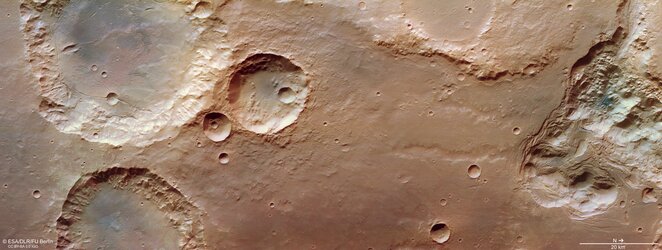

Fragmented terrain on Mars
Mars is very much a world of two halves – as highlighted by this new image from ESA’s Mars Express, which shows where the planet’s dramatically different hemispheres come together as one.
The northern hemisphere of Mars is flat, smooth and, in places, sits a few kilometres lower than the southern. The southern hemisphere, meanwhile, is heavily cratered, and peppered with pockets of past volcanic activity.
A transition zone known as ‘dichotomy boundary’ separates the northern lowlands and southern highlands. Large parts of this region are filled with something scientists call fretted terrain: blocky, broken-up, fragmented swathes of terrain where the rough, pockmarked martian south gives way to the smoother north. This image shows a region of fretted terrain named Nilosyrtis Mensae; channels, valleys and worn-away craters can be seen across the frame, reflecting the water, wind and ice erosion the region has experienced over martian history.
This image comprises data gathered on 29 September 2019 during orbit 19908. The ground resolution is approximately 15 m/pixel and the images are centred at about 69°E/31°N. This image was created using data from the nadir and colour channels of the High Resolution Stereo Camera (HRSC). The nadir channel is aligned perpendicular to the surface of Mars, as if looking straight down at the surface. North is to the right.
Full story: Two halves of a whole





